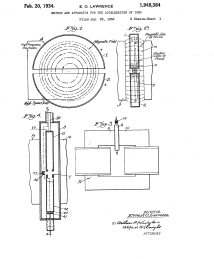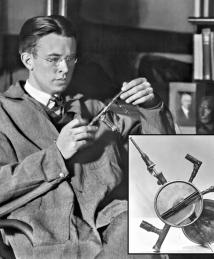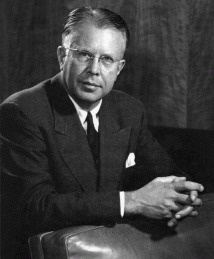Ernest Orlando Lawrence
Ernest Orlando Lawrence invented the cyclotron, a particle accelerator that uses a strong magnetic field to bend the path of charged particles, or protons, into a circle. Greatly increasing the speed with which projectiles could be shot at atomic nuclei, the cyclotron and related instruments made possible many advances in nuclear physics.
Lawrence was born in Canton, South Dakota, in 1901. An avid reader since childhood, he was particularly interested in science and engineering. He began his college education at St. Olaf College, then in 1919 transferred to the University of South Dakota, where he earned his bachelor’s degree in chemistry in 1922. After earning a master’s degree from the University of Minnesota in 1923, he spent a year studying physics at the University of Chicago and obtained his doctorate in physics from Yale University in 1925.
In 1927, Lawrence joined the faculty of the University of California, Berkeley, and by 1930, he became the youngest professor in Berkeley’s history. In 1929, while still an associate professor, Lawrence had been considering the problem of accelerating ions when he came across a sketch in a scientific article that inspired him to formulate the principles of the cyclotron.
Lawrence built his first cyclotron in 1930. Unlike other devices, which attempted to give charged particles one tremendous push, this device, now popularly known as an atom smasher, moved protons in a widening spiral, imparting more energy to them with each spin, until they finally shot out of the instrument. The spinning particles were used to torpedo atoms of numerous elements, disintegrating them. In some cases, the disintegration of the atoms formed entirely new elements.
The first cyclotron was small enough for Lawrence to hold in his hands, with a vacuum chamber measuring just 4 inches in diameter. He built much larger and more powerful machines over time, including one that contained a magnet weighing 4,000 tons.
In 1931, Lawrence founded the Lawrence Berkeley National Laboratory (then called the Berkeley Radiation Laboratory), where cyclotrons enabled discoveries including new elements, isotopes and subatomic particles.
Lawrence advocated for interdisciplinary collaboration among physicists and biologists. His brother Dr. John Lawrence, who was teaching at the Yale School of Medicine, visited Berkeley Lab in 1935 and later moved there in 1937. Together, the brothers began exploring the possibilities of biomedical applications of the cyclotron, and their multidisciplinary approach had a lasting impact on nuclear science. In fact, it became the blueprint for the Department of Energy’s national laboratory system. Today, cyclotrons are still used to produce particle beams for applications including nuclear medicine.
In 1939, at the age of 38, Lawrence became the youngest person to be awarded the Nobel Prize in Physics. When informed of this achievement, he said, “It goes without saying that it is the laboratory that is honored, and I share the honor with my co-workers past and present.” Lawrence’s many additional honors include the Hughes Medal of the Royal Society, the Medal for Merit, the Faraday Medal and the American Cancer Society Medal.
During World War II, Lawrence worked on the Manhattan Project and helped establish the radiation laboratory at the Massachusetts Institute of Technology. Interested in peaceful applications of atomic energy, he also played a key role in creating the United States Atomic Energy Commission, and he served as a commissioner from 1947 until his death in 1958.
The Ernest Orlando Lawrence Award was established in 1959, honoring U.S. scientists and engineers for their contributions in research supporting the Department of Energy. When the award was initially proposed, President Dwight D. Eisenhower said, “Such an award would seem to me to be most fitting, both as a recognition of what he has given to our country and to mankind, and as a means of helping to carry forward his work through inspiring others to dedicate their lives and talents to scientific effort.”



